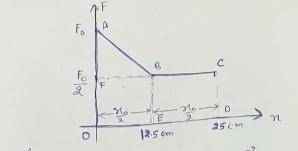
Physics, 24.07.2020 20:01 mmassaro19
In the school cafeteria, a trouble-making child blows a 12.0 g spitball through a 25.0 cm straw. The force (F) in Newtons, of his breath as a function of the distance along the straw (x) in meters, can be modeled as a linearly decreasing function for the first half of the straw, followed by a constant force through the rest of the straw. The force decreases by half along the first half of the straw. Assume there is negligible friction and the straw is held horizontally.
(a) Sketch a plot of the force of his breath as a function of position along the straw, labeling the force at x = 0 as F0.
(b) If the spitball begins from rest and leaves the straw with a speed of 16 m/s, how much work is done on the spitball?
(c) What is the maximum force F0, that acts on the spitball?

Answers: 3


Another question on Physics

Physics, 21.06.2019 19:10
Athin, square metal plate measures 14 cm on each side and has emissivity of 0.60. the plate is heated to a temperature of 745°c. what is the rate at which the plate radiates energy ? the stefan-boltzmann constant is 5.67 × 10-8 w/(m2 ? k4). remember that the plate will radiate energy from both its top and bottom surfaces.
Answers: 1

Physics, 22.06.2019 12:20
A2.0 μf capacitor and a 4.0 μf capacitor are connected in series across a 0.827-kv potential. the charged capacitors are then disconnected from the source and connected to each other with terminals of like sign together. find the voltage across each capacitor.
Answers: 2

Physics, 22.06.2019 15:20
Your science teacher brings in a speaker to talk to your class about climate change. during the session, students ask a few questions. which questions are related to the current evidence on climate change
Answers: 3

Physics, 22.06.2019 20:50
An ideal otto cycle has a compression ratio of 8. at the beginning of the compression process, air is at 95 kpa and 27°c, and 750 kj/kg of heat is transferred to air during the constant-volume heat-addition process. assuming constant specific heats at room temperature, determine (a) the pressure and temperature at the end of the heat-addition process, (b) the net work output, (c) the thermal efficiency, and (d) the mean effective pressure for the cycle. (4390 kpa, 1730 k; 423 kj/kg; 56.4%; 534 kpa)
Answers: 1
You know the right answer?
In the school cafeteria, a trouble-making child blows a 12.0 g spitball through a 25.0 cm straw. The...
Questions

History, 29.10.2019 09:31




Mathematics, 29.10.2019 09:31

English, 29.10.2019 09:31

Mathematics, 29.10.2019 09:31

Biology, 29.10.2019 09:31

History, 29.10.2019 09:31


Mathematics, 29.10.2019 09:31

Mathematics, 29.10.2019 09:31

Biology, 29.10.2019 09:31




Mathematics, 29.10.2019 09:31

Arts, 29.10.2019 09:31

English, 29.10.2019 09:31

 c) Maximum force =
c) Maximum force = 


![F_0 = \frac{8w}{5x_0}\\\\F_0 = \frac{8*1.536}{5*25*10^[-2]}\\\\F_0 = 6.4N](/tpl/images/0712/5523/342e1.png)




